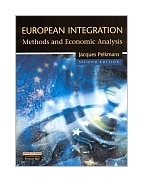|
||
• wydawnictwa polskie
• Zamów informacje o nowościach z wybranego tematu • kontakt
• Cookies na stronie |
EUROPEAN INTEGRATIONPELKMANS J.wydawnictwo: FT/PH , rok wydania 2001, wydanie IIcena netto: European Integration
Methods and Economic Analysis2nd Edition Written by one of Europe's leading analysts of the EU, European Integration uniquely combines economic analysis with a detailed knowledge of the integration methods employed in the European Union. Application of the economic analysis is demonstrated through numerous practical examples and specially written case studies which help to bridge the gap between theory and policy practice. The new edition of this highly respected text has been thoroughly updated to include all recent developments in the field of European integration, including the Amsterdam Treaty, the arrival of the euro and issues surrounding enlargement. European Integration has been carefully designed to appeal to a wide range of students studying economic integration as part of an economics, business, law or public administration degree. Unique integration of economic theory with EU regulatory & policy framework. Non-mathematical treatment of economic theory. Innovative analysis of the economics of subsidiarity and the economic constitution of the EU. Economic theory is presented using graphical, non-algebraic tools Numerous case studies are included throughout, many of direct relevance to business. Contents List of Tables & Figures List of Case Studies List of Abbreviations PART 1 FOUNDATION Chapter 1 What is Economic Integration? Definition and significance Economic and political integration Institutional aspects of economic integration Market integration and other forms The stages of economic integration Economic integration and the WTO Economic integration and economic federalism Summary Appendix 1.1 European Institutions: a brief guide Appendix 1.2 New numbering of treaty articles following Amsterdam Chapter 2 Developing Economic Integration in the Union How Western Europe s regionalism emerged Aspirations of the founders Deepening, widening and enlargement Aspirations of the Maastricht Treaty Meaning of the Amsterdam treaty Summary Chapter 3 Economic Constitution of the EU An economic constitution for integration The economic constitution in the Rome Treaty The value-added of the Single Act The Maastricht treaty The incrementalism of the Amsterdam treaty Summary Chapter 4 Subsidiarity and Economic Functions of the Union The economics of subsidiarity A subsidiarity test for the Union Subsidiarity and EU regulatory strategy Subsidiarity and non-regulatory EU functions Summary PART 2 INTERNAL MARKET Chapter 5 Product Market Integration: The Method The framework for product market integration Building the Customs Union From customs union to product market integration Removing barriers in the internal market Summary Chapter 6 Product Market Integration: Economic Analysis The basic theory of customs union Customs union and technical efficiency Customs union and decreasing costs Empirical studies The pro-competitive effects of a customs union The economic impact of EC-1992 Price convergence in the internal market Summary Chapter 7 Services Market Integration: The Method and Economic Analysis The legal framework for services market integration Why regulate: market failures in services Financial services: the EU regulatory framework Financial services: the economic impact Road haulage Summary Chapter 8 The internal market for network industries Network industries and the EC treaty The economics of network industries Establishing the internal market for network industries Air transport Telecoms Summary Chapter 9 Factor Market Integration: The Method Financial capital Labour Technology and commercial ideas Corporate control and mobility of tangible assets Summary Chapter 10 Factor Market Integration: Economic Analysis Factor mobility in simple two-country models Economic significance of factor market integration The EU financial capital market An emerging Euro-labour market? An EU market for technology? Europeanisation of business Locational competition for mobile assets Summary PART 3 COMMON POLICIES Chapter 11 Common Agricultural Policy A case for the CAP? Objectives, principles and instruments Income protection, alternative CAP methods Assessing the CAP in actual practice Reforming the CAP Summary Chapter 12. EC Competition Policy Why EC competition policy? The Community's competition regime Anti-collusion policy Anti-monopoly policy Merger Control Controlling stateaids Summary Chapter 13 Common Trade Policy Why a common trade policy? Principle, objectives and instruments Types of EC trade policy Tariff protection Volume protection Anti-dumping: trade policy instead of competition policy Preferential trade policy Multilateral trade policy Summary Chapter 14 EC Industrial Policy How to justify industrial policy Why a common industrial policy? Sector policies EC technology policies Horizontal policies Summary PART 4 EQUITY, STABILISATION AND EXTENSION Chapter 15 Equity for the Union? Social Policy, Cohesion and the EU Budget The small social acquis of the Union Subsidiarity and social policy The economics of cohesion Cohesion policies and subsidiarity The Structural Funds and real convergence The fundamental dilemma of the EU budget Summary Chapter 16 European Macro Economic Cooperation Macro-economic cooperation under the Rome Treaty Autonomy versus cooperation in a Mundell-Fleming model New approaches to macro-economic policy making The European Monetary System Why beyond the EMS? Summary Chapter 17 Economic and Monetary Union The costs and benefits of monetary union Economic union Towards monetary union What kind of monetary union? Micro-macro links in euroland Monetary and fiscal policies External aspects of the euro Summary Chapter 18 Pan-European Economic Integration Economic analysis of a free trade area EFTA moving into the Union The pan-European process under way Economic integration with Central Europe The Mediterranean connection Summary 418 pages Księgarnia nie działa. Nie odpowiadamy na pytania i nie realizujemy zamówien. Do odwolania !. |


